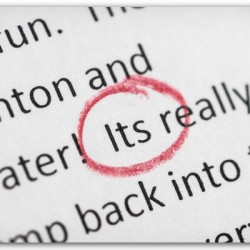When attending school you were most likely taught when starting your essays and compositions that they should have a beginning, a middle and an end. You would also have been taught the joys of English spelling and grammar, to a greater or lesser degree. And if you are one of the majority, then you probably found it all a bit complicated and promptly forgot most of it on leaving school.
The fact is that English is a complicated language; it is well known as one of the most difficult for foreign students to learn, although many, usually authors and avid readers, would counter that view by commenting on its richness and variety.
Whichever camp you are in, it is little wonder that most people struggle with the written word. Whether beginning with a letter complaining about bad service or an article for the local church magazine, a description of an item to sell on eBay or a story for a competition, there are some common mistakes that are made, which by remembering a few simple tricks and techniques are very easy to avoid.
Many people comment that they are not good at spelling, but there is no excuse for misspelt words. Most people have access to computers, all of which have spell checker facilities. If you do not, use a dictionary. There is nothing that diminishes the power of written communication more than bad spelling.
Avoid Spelling and Grammar Mistakes
Within the context of bad spelling you have to include words that sound the same but have two spellings and two meanings, like “there” and “their”, “where” and “were” etc. Spell checkers won’t spot this, so check your dictionary.
Unless you are working on a creative writing piece, usually your readers will be busy people, so get straight to the point. Long winded, rambling, wordy descriptions are not necessary in most communication and usually detract from the main point or argument, so avoid them.
If you are a bit shaky with your grammar, just use simple sentences with simple punctuation, that way you can be sure of getting it right. Simple language can often also be far more impactful – and you can guarantee that your reader will understand exactly what you are saying.
Think about the structure of the piece you are working on. Your teacher was right in saying it should have a beginning, a middle and an end, and it’s a good idea to think about what you want to say in each of these three ”sections” before you start to write. Introduce your reader to the subject matter, state the crux of the issue then conclude. This works no matter what you are writing. Take our complaint letter for example:-
Introduction: I am sending this to complain about the service I received from your company on 1st February last.
Body of letter: The specific issues I wish to raise with you are… list of complaints.
Conclusion: I believe that, under the circumstances outlined above, I am entitled to compensation of $0.00 and look forward to receiving this.
Think about anything that you might find yourself working on, and apply this simple structure.
Finally, we must conclude with use of the apostrophe. This little black mark hovering on the page must be the most misunderstood piece of punctuation in the English language. The apostrophe has two uses; to denote possession (Sandra’s house), or to indicate where one or more letters are missing, usually when words have been abbreviated (“don’t”, rather than “do not”). Apostrophes are NOT used to denote plurals; the plural of “cup” is “cups”, not “cup’s”. Confusion sometimes arises when both plural and possession are indicated, but there is a simple rule. The apostrophe goes after the persons or entities that have possession (“the dogs’ beds” – implying more than one bed belonging to more than one dog; “those companies’ shares” – in other words, “the shares belonging to those companies; “the Parkers’ house” – the house belonging to the Parker family)
Following these simple student guidelines will mean that all your written communication is effective and easily understood and will achieve the results you want.


